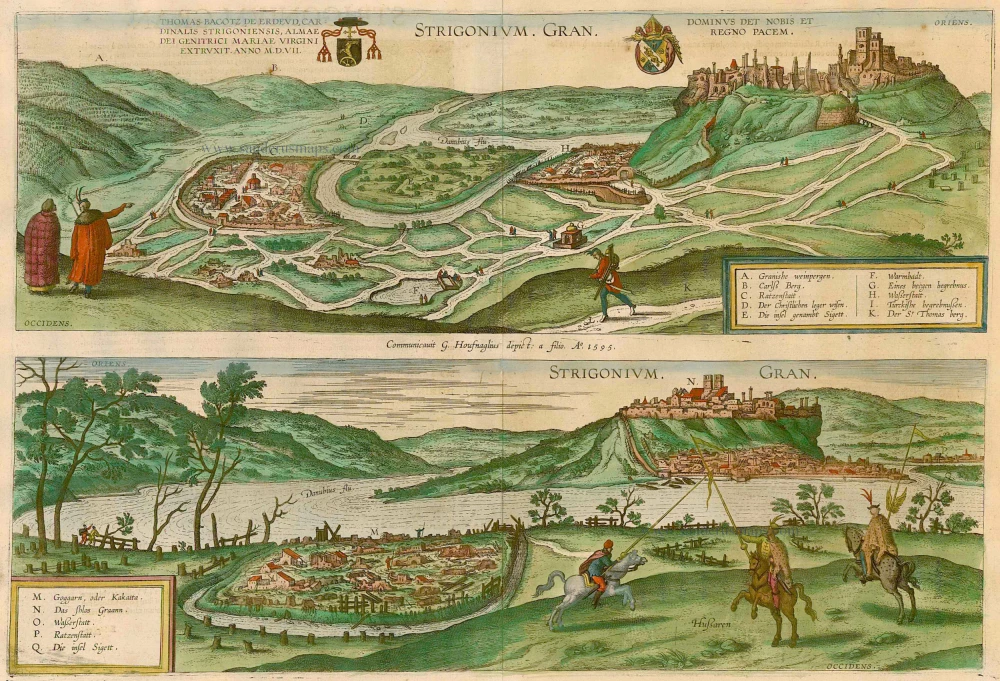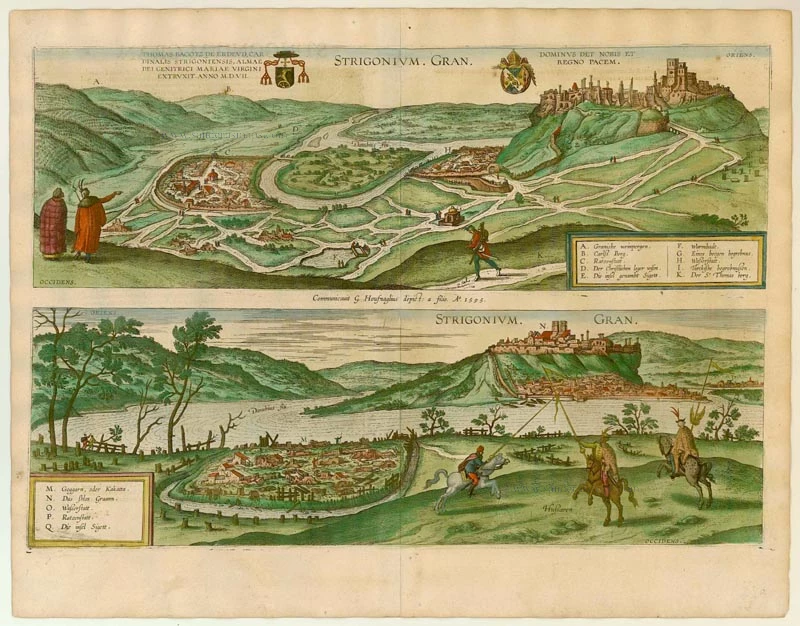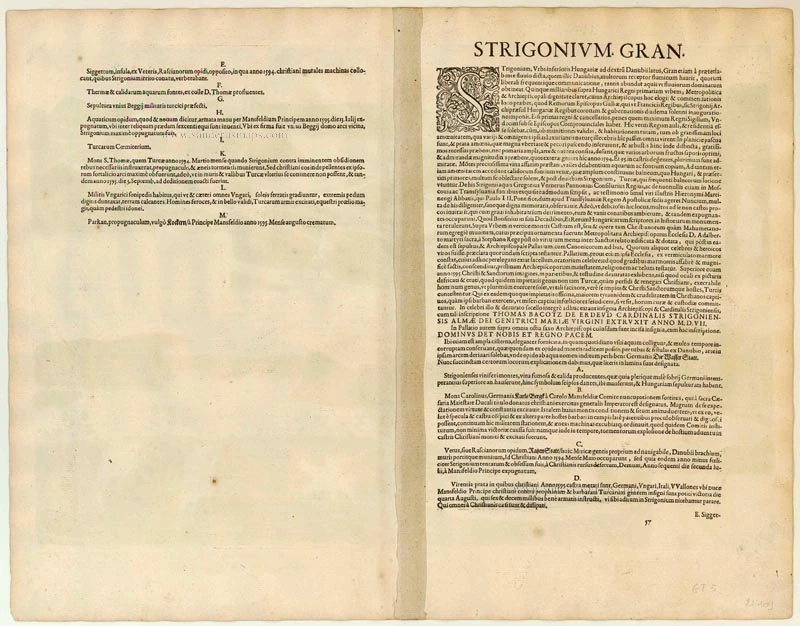Antique map of (Hungary) Esztergom by Braun & Hogenberg 1596
Antique map - two views of Esztergom (Hungary) by Braun & Hogenberg after G. Hoefnagel's son, 1595.
COMMENTARY BY BRAUN (on verso): "Esztergom, also called Gran, is a town in Lower Hungary on the right bank of the Danube [...]. It is the seat of an archbishop, all the more praiseworthy because the archbishop of Gran crowns the kings of Hungary in a special ceremony. [...] The kings used to hold court here on account of its secure fortifications and also its protected apartments. Above the town, on the summit of the hill, lies a castle. [...] The town is embellished in particular by its cathedral, which is dedicated to St Adalbert the Martyr."
The town of Esztergom, ravaged by the Turks in 1542, is presented from two viewpoints. The top illustration is seen from the east and shows the castle ruins overlooking the town at the confluence of the Hron and the Danube. The bottom illustration shows the destroyed Lower Town and the castle from the west. In the left-hand foreground, on the left bank of the Danube, lies the similarly razed village of Parkany (M). In the Middle Ages Esztergom was one of the most important royal palaces and the seat of the archbishops of Esztergom. In the 12th century King Béla III of Hungary made Esztergom his sole residence and confirmed the town as the centre of political and cultural life in Hungary during this era. With the relocation of the royal residence to Visegrad, Esztergom and the palace passed into possession of the archbishop; indeed, the Primate of Hungary continues to reside in the town even today. In the 16th century Esztergom was reduced to a small provincial town following its conquest by the Turks, in whose hands it remained until 1683. Not until the 18th century and the return of the archbishops from their exile in Trnava did the town flourish anew. (Taschen).
Date on map: 1595
Braun G. & Hogenberg F. and the Civitates Orbis Terrarum.
The Civitates Orbis Terrarum, also known as the 'Braun & Hogenberg', is a six-volume town atlas and the most excellent book of town views and plans ever published: 363 engravings, sometimes beautifully coloured. It was one of the best-selling works in the last quarter of the 16th century. Georg Braun, a skilled writer, wrote the text accompanying the plans and views on the verso. Many plates were engraved after the original drawings of a professional artist, Joris Hoefnagel (1542-1600). The first volume was published in Latin in 1572 and the sixth in 1617. Frans Hogenberg, a talented engraver, created the tables for volumes I through IV, and Simon van den Neuwel made those for volumes V and VI. Other contributors were cartographers Daniel Freese and Heinrich Rantzau, who provided valuable geographical information. Works by Jacob van Deventer, Sebastian Münster, and Johannes Stumpf were also used as references. Translations appeared in German and French, making the atlas accessible to a wider audience.
Since its original publication of volume 1 in 1572, the Civitates Orbis Terrarum has left an indelible mark on the history of cartography. The first volume was followed by seven more editions in 1575, 1577, 1582, 1588, 1593, 1599, and 1612. Vol.2, initially released in 1575, saw subsequent editions in 1597 and 1612. The subsequent volumes, each a treasure trove of historical insights, graced the world in 1581, 1588, 1593, 1599, and 1606. The German translation of the first volume, a testament to its widespread appeal, debuted in 1574, followed by the French edition in 1575.
Several printers were involved: Theodor Graminaeus, Heinrich von Aich, Gottfried von Kempen, Johannis Sinniger, Bertram Buchholtz, and Peter von Brachel, all of whom worked in Cologne.
Georg Braun (1541-1622)
Georg Braun, the author of the text accompanying the plans and views in the Civitates Orbis Terrarum, was born in Cologne in 1541. After his studies in Cologne, he entered the Jesuit Order as a novice, indicating his commitment to learning and intellectual pursuits. In 1561, he obtained his bachelor's degree; in 1562, he received his Magister Artium, further demonstrating his academic achievements. Although he left the Jesuit Order, he continued his studies in theology, gaining a licentiate in theology. His theological background likely influenced the content and tone of the text in the Civitates Orbis Terrarum, adding a unique perspective to the work.
Frans Hogenberg (1535-1590)
Frans Hogenberg was a Flemish and German painter, engraver, and mapmaker. He was born in Mechelen as the son of Nicolaas Hogenberg.
By the end of the 1560s, Frans Hogenberg was employed upon Abraham Ortelius's Theatrum Orbis Terrarum, published in 1570; he is named an engraver of numerous maps. In 1568, he was banned from Antwerp by the Duke of Alva and travelled to London, where he stayed a few years before emigrating to Cologne. He immediately embarked on his two most important works, the Civitates, published in 1572 and the Geschichtsblätter, which appeared in several series from 1569 until about 1587.
Thanks to large-scale projects like the Geschichtsblätter and the Civitates, Hogenberg's social circumstances improved with each passing year. He died as a wealthy man in Cologne in 1590.
Strigonium. Gran
Item Number: 22109 Authenticity Guarantee
Category: Antique maps > Europe > Central Europe
Antique map - two views of Esztergom (Hungary) by Braun & Hogenberg after G. Hoefnagel's son, 1595.
COMMENTARY BY BRAUN (on verso): "Esztergom, also called Gran, is a town in Lower Hungary on the right bank of the Danube [...]. It is the seat of an archbishop, all the more praiseworthy because the archbishop of Gran crowns the kings of Hungary in a special ceremony. [...] The kings used to hold court here on account of its secure fortifications and also its protected apartments. Above the town, on the summit of the hill, lies a castle. [...] The town is embellished in particular by its cathedral, which is dedicated to St Adalbert the Martyr."
The town of Esztergom, ravaged by the Turks in 1542, is presented from two viewpoints. The top illustration is seen from the east and shows the castle ruins overlooking the town at the confluence of the Hron and the Danube. The bottom illustration shows the destroyed Lower Town and the castle from the west. In the left-hand foreground, on the left bank of the Danube, lies the similarly razed village of Parkany (M). In the Middle Ages Esztergom was one of the most important royal palaces and the seat of the archbishops of Esztergom. In the 12th century King Béla III of Hungary made Esztergom his sole residence and confirmed the town as the centre of political and cultural life in Hungary during this era. With the relocation of the royal residence to Visegrad, Esztergom and the palace passed into possession of the archbishop; indeed, the Primate of Hungary continues to reside in the town even today. In the 16th century Esztergom was reduced to a small provincial town following its conquest by the Turks, in whose hands it remained until 1683. Not until the 18th century and the return of the archbishops from their exile in Trnava did the town flourish anew. (Taschen).
Date of the first edition: 1596
Date of this map: 1596
Date on map: 1595
Copper engraving
Size: 35 x 51.5cm (13.7 x 20.1 inches)
Verso text: Latin
Condition: Old coloured, excellent.
Condition Rating: A
References: Van der Krogt 4, 1274; Taschen, Braun and Hogenberg, p.416.
From: Urbium Praecipuarum Mundi Theatrum Quintum Auctore Georgio Braunio Agrippinate. Part 5. Köln, 1596/97. (Van der Krogt 4, 41:1.5)
Antique map - two views of Esztergom (Hungary) by Braun & Hogenberg after G. Hoefnagel's son, 1595.
COMMENTARY BY BRAUN (on verso): "Esztergom, also called Gran, is a town in Lower Hungary on the right bank of the Danube [...]. It is the seat of an archbishop, all the more praiseworthy because the archbishop of Gran crowns the kings of Hungary in a special ceremony. [...] The kings used to hold court here on account of its secure fortifications and also its protected apartments. Above the town, on the summit of the hill, lies a castle. [...] The town is embellished in particular by its cathedral, which is dedicated to St Adalbert the Martyr."
The town of Esztergom, ravaged by the Turks in 1542, is presented from two viewpoints. The top illustration is seen from the east and shows the castle ruins overlooking the town at the confluence of the Hron and the Danube. The bottom illustration shows the destroyed Lower Town and the castle from the west. In the left-hand foreground, on the left bank of the Danube, lies the similarly razed village of Parkany (M). In the Middle Ages Esztergom was one of the most important royal palaces and the seat of the archbishops of Esztergom. In the 12th century King Béla III of Hungary made Esztergom his sole residence and confirmed the town as the centre of political and cultural life in Hungary during this era. With the relocation of the royal residence to Visegrad, Esztergom and the palace passed into possession of the archbishop; indeed, the Primate of Hungary continues to reside in the town even today. In the 16th century Esztergom was reduced to a small provincial town following its conquest by the Turks, in whose hands it remained until 1683. Not until the 18th century and the return of the archbishops from their exile in Trnava did the town flourish anew. (Taschen).
Date on map: 1595
Braun G. & Hogenberg F. and the Civitates Orbis Terrarum.
The Civitates Orbis Terrarum, also known as the 'Braun & Hogenberg', is a six-volume town atlas and the most excellent book of town views and plans ever published: 363 engravings, sometimes beautifully coloured. It was one of the best-selling works in the last quarter of the 16th century. Georg Braun, a skilled writer, wrote the text accompanying the plans and views on the verso. Many plates were engraved after the original drawings of a professional artist, Joris Hoefnagel (1542-1600). The first volume was published in Latin in 1572 and the sixth in 1617. Frans Hogenberg, a talented engraver, created the tables for volumes I through IV, and Simon van den Neuwel made those for volumes V and VI. Other contributors were cartographers Daniel Freese and Heinrich Rantzau, who provided valuable geographical information. Works by Jacob van Deventer, Sebastian Münster, and Johannes Stumpf were also used as references. Translations appeared in German and French, making the atlas accessible to a wider audience.
Since its original publication of volume 1 in 1572, the Civitates Orbis Terrarum has left an indelible mark on the history of cartography. The first volume was followed by seven more editions in 1575, 1577, 1582, 1588, 1593, 1599, and 1612. Vol.2, initially released in 1575, saw subsequent editions in 1597 and 1612. The subsequent volumes, each a treasure trove of historical insights, graced the world in 1581, 1588, 1593, 1599, and 1606. The German translation of the first volume, a testament to its widespread appeal, debuted in 1574, followed by the French edition in 1575.
Several printers were involved: Theodor Graminaeus, Heinrich von Aich, Gottfried von Kempen, Johannis Sinniger, Bertram Buchholtz, and Peter von Brachel, all of whom worked in Cologne.
Georg Braun (1541-1622)
Georg Braun, the author of the text accompanying the plans and views in the Civitates Orbis Terrarum, was born in Cologne in 1541. After his studies in Cologne, he entered the Jesuit Order as a novice, indicating his commitment to learning and intellectual pursuits. In 1561, he obtained his bachelor's degree; in 1562, he received his Magister Artium, further demonstrating his academic achievements. Although he left the Jesuit Order, he continued his studies in theology, gaining a licentiate in theology. His theological background likely influenced the content and tone of the text in the Civitates Orbis Terrarum, adding a unique perspective to the work.
Frans Hogenberg (1535-1590)
Frans Hogenberg was a Flemish and German painter, engraver, and mapmaker. He was born in Mechelen as the son of Nicolaas Hogenberg.
By the end of the 1560s, Frans Hogenberg was employed upon Abraham Ortelius's Theatrum Orbis Terrarum, published in 1570; he is named an engraver of numerous maps. In 1568, he was banned from Antwerp by the Duke of Alva and travelled to London, where he stayed a few years before emigrating to Cologne. He immediately embarked on his two most important works, the Civitates, published in 1572 and the Geschichtsblätter, which appeared in several series from 1569 until about 1587.
Thanks to large-scale projects like the Geschichtsblätter and the Civitates, Hogenberg's social circumstances improved with each passing year. He died as a wealthy man in Cologne in 1590.






